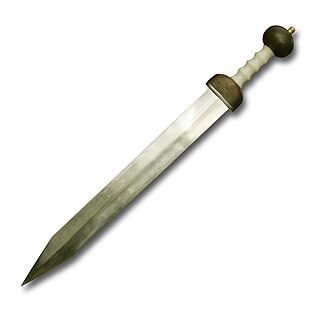
Gladius is a Latin word properly referring to the type of sword that was used by ancient Roman foot soldiers starting from the 3rd century BC and until the 3rd century AD. Linguistically, within Latin, the word also came to mean "sword", regardless of the type used.

Rapper sword is a variation of sword dance unique to Northumberland and County Durham. It emerged from the pit villages of Tyneside and Wearside, where miners first performed the tradition.
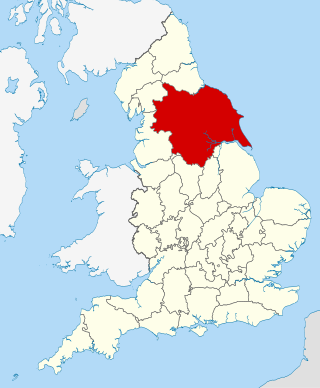
The Long Sword dance is a hilt-and-point sword dance recorded mainly in Yorkshire, England. The dances are usually performed around Christmas time and were believed to derive from a rite performed to enable a fruitful harvest.

The kris or keris is a Javanese asymmetrical dagger with a distinctive blade-patterning achieved through alternating laminations of iron and nickelous iron (pamor). The kris is famous for its distinctive wavy blade, although many have straight blades as well, and is one of the weapons commonly used in the pencak silat martial art native to Indonesia. Kris have been produced in many regions of Indonesia for centuries, but nowhere—although the island of Bali comes close—is the kris so embedded in a mutually-connected whole of ritual prescriptions and acts, ceremonies, mythical backgrounds and epic poetry as in Central Java. Within Indonesia the kris is commonly associated with Javanese culture, although other ethnicities in it and surrounding regions are familiar with the weapon as part of their cultures, such as the Balinese, Sundanese, Malay, Madurese, Banjar, Buginese, and Makassar people. The kris itself is considered as a cultural symbol of Indonesia and neighbouring Malaysia.

The kampilan is a type of single-edged sword, traditionally used by various ethnic groups in the Philippine archipelago. It has a distinct profile, with the tapered blade being much broader and thinner at the point than at its base, sometimes with a protruding spikelet along the flat side of the tip. The design of the pommel varies between ethnic groups, but it usually depicts either a buaya (crocodile), a bakunawa, a kalaw (hornbill), or a kakatua (cockatoo)..

The nagamaki is a type of traditionally made Japanese sword (nihontō) with an extra long handle, used by the samurai class of feudal Japan.

The Democratic League of Kosovo is the oldest and one of the largest political parties in Kosovo.
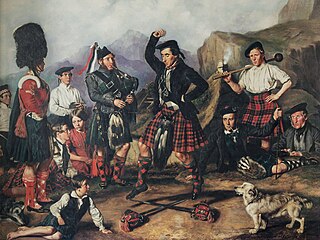
The Sword dance is one of the best known of all Highland dances, an ancient dance of war. Performance of sword dances in the folklore of Scotland is recorded from as early as the 15th century.
The weapon dance employs weapons—or stylized versions of weapons—traditionally used in combat in order to simulate, recall, or reenact combat or the moves of combat in the form of dance, usually for some ceremonial purpose. Such dancing is quite common to folk ritual on many parts of the world. Weapon dancing is certainly ancient; among the earliest historical references we have are those that refer to the pyrrhichios, a weapon dance in ancient Sparta, in which the dance was used as a kind of ritual training for battle.

A war dance is a dance involving mock combat, usually in reference to tribal warrior societies where such dances were performed as a ritual connected with endemic warfare. Martial arts in various cultures can be performed in dance-like settings for various reasons, such as for evoking ferocity in preparation for battle or showing off skill in a more stylized manner. It could also be for celebration of valor and conquest. Many such martial arts incorporate music, especially strong percussive rhythms.

Rugova Canyon or Rugova Gorge is a river canyon near Peja in Western Kosovo, in the Albanian Alps, close to the border with Montenegro. With a length of 25 km (16 mi) and a depth up to 1,000 meters, Rugova is considered to be one of Europe's longest and deepest canyons. It was created by water erosion and the retreat of the Peja glacier. The Lumbardhi i Pejës river cuts through the canyon.

The panabas, also known as nawi, is a large, curved sword used by certain ethnic groups in the southern Philippines. It can range in size from 2 to 4 feet and can be held with one or both hands, delivering a deep, meat cleaver-like cut. In its heyday, it was used as a combat weapon, as an execution tool, and as a display of power. Occasional use as an agricultural and butchering tool has also been noted.

The bacchu-ber, derived from Occitan bau cubèrt, is a traditional folk dance performed with swords. This dance takes place in the district of Pont-de-Cervières, city of Briançon. Its origin dates back to many centuries ago. This folk dance is unique in France and is one of the rare sword dances that have stood the test of time. It is performed once a year on 16 August, day of Saint Roch (1340–1379), patron of the Pont-de-Cervières district. Similar shows are performed on the Italian side of the Cottian Alps, notably in San Giorio, Fenestrelle and Giaglione villages.

Italian folk dance has been an integral part of Italian culture for centuries. Dance has been a continuous thread in Italian life from Dante through the Renaissance, the advent of the tarantella in Southern Italy, and the modern revivals of folk music and dance.
![<span class="mw-page-title-main">Chholiya</span> Dance form practised in the [[Kumaon division|Kumaon]] region of India](https://upload.wikimedia.org/wikipedia/commons/thumb/9/9e/Cholliyar.jpg/320px-Cholliyar.jpg)
Chholiya or Hudkeli is a traditional folk dance form originated in the Kumaon division of the Indian state of Uttarakhand and Sudurpashchim province of Nepal. It has today become a symbol of Kumaoni and Sudurpashchimi cultures. It is basically a sword dance accompanying a marriage procession but now it is performed on many auspicious occasions.

Folk dance of Mexico, commonly known as baile folklorico or Mexican ballet folk dance, is a term used to collectively describe traditional Mexican folk dances. Ballet folklórico is not just one type of dance; it encompasses each region's traditional dance that has been influenced by their local folklore and has been entwined with ballet characteristics to be made into a theatrical production. Each dance represents a different region in Mexico illustrated through their different zapateado, footwork, having differing stomps or heel toe points, and choreography that imitates animals from their region such as horses, iguanas, and vultures.

The Rugova war dance is a traditional Albanian sword dance named after the Rugova region in Kosovo.

Rugova is a mountain region located to the north-west of the city of Peja, in Kosovo. According to notes of Rugova it has been inhabited since before the 12th century. In 2013, it was designated a national park by the Parliament of Kosovo.

Balato is a sword that originates from Nias, an island off the west coast of North Sumatra, Indonesia.

Firkal is a martial art folk-dance of Bhumij tribe. The main instruments of Firkal are swords, arrows, bows and shields. It can be found in Potka block of Jharkhand and some parts of Odisha, India.






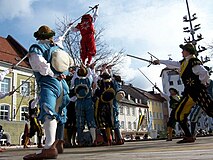


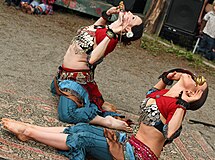













![<span class="mw-page-title-main">Chholiya</span> Dance form practised in the [[Kumaon division|Kumaon]] region of India](https://upload.wikimedia.org/wikipedia/commons/thumb/9/9e/Cholliyar.jpg/320px-Cholliyar.jpg)




